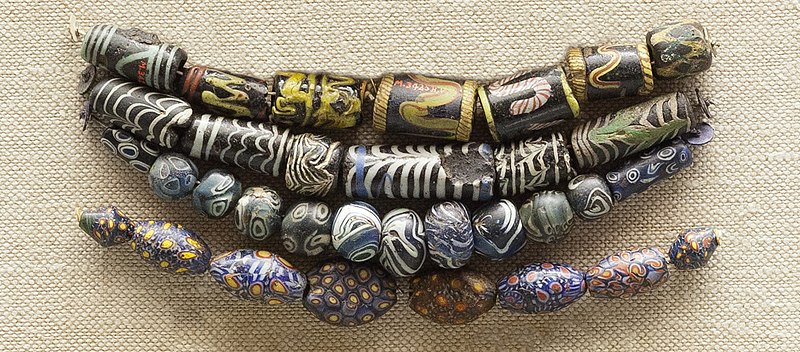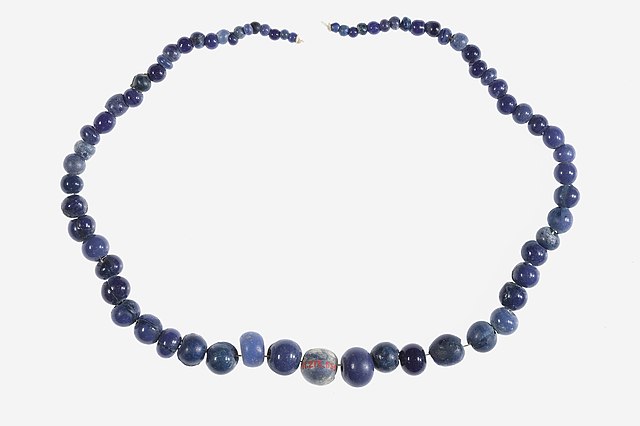
Thammasat University students who are interested in art, archaeology, economics, colonialism, history, social and cultural anthropology, ethnography, folklore, and related subjects may find a newly available book useful.
The Elemental Analysis of Glass Beads: Technology, Chronology and Exchange is an Open Access book, available for free download at this link:
https://library.oapen.org/handle/20.500.12657/58572
The TU Library collection includes some other books about different aspects of glass bead production.
Ancient glass beads have been produced and traded globally for thousands of years. Modern archaeologists study these artifacts through sophisticated methods that analyze the glass composition, a process which can be used to trace bead usage through time and across regions. The geographic range includes studies of beads produced in Europe and traded widely across North America and beads from South and Southeast Asia traded around the Indian Ocean and beyond. The contributors provide new insight on the timing of interregional interactions, technologies of bead production and patterns of trade and exchange, using glass beads as a window to the past.

One chapter of the book focuses on The exchange of beads in Central Thailand in the protohistoric period: Glass objects from Phromthin Tai.
This chapter begins:
Phromthin Tai, sometimes spelled Promtin Tai, is a multi-component site located in Central Thailand, about 20 km from the provincial capital of Lopburi. The Thai Fine Arts Department undertook a small excavation in 1991, which uncovered prehistoric and Early Historic period artifacts. Since 2004, Dr. Thanik Lertcharnrit from the Department of Archaeology at Silpakorn University has led frequent excavations at the site (Lertcharnrit 2006). These more recent studies show evidence for habitation from the late Bronze Age period (approx. 700 BCE) through the mid-late first millennium CE or Dvaravati period. The most intensive habitation at the site dates to the Iron Age or protohistoric period (approx. 500 BCE – 500 CE) and in 2007 a cemetery was uncovered (PTT-S3) containing 36 individuals in 35 burials. Although comprehensive radiocarbon dating of the burials has not yet been undertaken, burials can be divided into Earlier and Later Iron Age periods. While beads were common throughout the cemetery matrix only 12 burials, which primarily dated to the Earlier Iron Age period, contained stone and glass beads as grave goods and of these just eight contained glass beads. Five subsequent field seasons between 2009 and 2019 have uncovered a further 34 burials from unit PTT-S4, although these burials have fewer beads than the S3 burials. The protohistoric period was a time of great change in Southeast Asia. It is during this period that contact with South Asia began, as evidenced by South Asian products appearing in Southeast Asian archaeological sites, especially burials Glass and stone beads are one common marker of this period across Southeast Asia. While early scholars assumed beads were largely imported as finished products, excavations in peninsular Thailand and Myanmar demonstrate the presence of stone and glass jewelry workshops using both local and South Asian beadmaking techniques to produce beads and ornaments for local markets. Analysis of glass and stone beads has demonstrated that there was a great diversity of bead types in circulation, which represented different manufacturing, trading, and interaction networks both within Southeast Asia and between South Asia and Southeast Asia. Several studies have noted differing intensities of interaction with South Asia, with an earlier period dating to the late first millennium BCE that was less intense but circulated higher-quality imported goods and a later period dating to the earlymid first millennium CE in which interaction was more frequent and contained higher quantities of mass-produced or lower-quality goods. These changing interaction networks extended to the exchange of beads, which saw differing types and qualities of beads moving on different networks within mainland Southeast Asia. An earlier South China Sea exchange network connected sites primarily on the coasts or with coastal connections and especially circulated potash glass; Carter 2015; Hung et al. 2013). A later network circulated larger quantities of glass beads, largely made from high alumina mineral soda glass, connecting sites farther inland via the “Mekong Interaction Sphere”. Located in central Thailand near a highly productive copper mining and bronzeworking region, the community at Phromthin Tai was well-suited to participating in interaction networks with communities in the north, east, and west. Previous studies of glass beads in mainland Southeast Asia have largely focused on Cambodia and northeast Thailand, peninsular Thailand, and most recently Myanmar. An analysis of beads from Phromthin Tai fills a geographic gap in our knowledge regarding the circulation of beads in this region. The goal of this study was to determine the types of glass beads and objects found at the site and begin connecting Phromthin Tai to existing glass exchange networks. In doing so, we aim to elucidate Phromthin Tai’s place within these regional systems. This chapter reviews the results of analyses of 63 glass artifacts, primarily beads, recovered from burial contexts. Carter recorded over 1000 glass and stone beads, of which approximately 960 were glass, from the 2007 excavation as part of her PhD dissertation research…

Conclusion: Phromthin Tai’s diverse glass collection demonstrates that this community participated in several bead exchange networks over the course of its long occupation. The predominance of potash glass beads in burials suggests people. The Elemental Analysis of Glass Beads at this site were connected to the larger South China Sea bead exchange routes during the early Iron Age that also included coastal sites in peninsular Thailand, as well as Sa Huynh and Dong Son sites in Vietnam, the Samon Valley and peninsular Myanmar, and southeast Cambodia. Several unusual beads are similar to beads found largely in peninsular Thailand, such as those made with m-Na-Ca-Al glass, gold-glass beads, and faience and imitation agate beads, signifying a trade relationship with these communities or that they were part of the same trade network(s). The presence of numerous high alumina mineral soda glass beads in the cemetery matrix and upper layers indicate that people at this site maintained regional connections as bead exchange networks shifted in the early first millennium CE and exchange within the Mekong Interaction Sphere expanded. Researchers had previously suggested the shift from potash to high alumina mineral soda glass took place between 200 BCE-200 CE, based on a lack of potash beads in cemetery layers at the site of Angkor Borei, Cambodia. Burial 20 at Phromthin Tai is especially important in this regard, as it contained both potash glass and m-Na-Al 1 glass and may help date the transition or overlap between these two exchange networks within mainland Southeast Asia (Carter 2015). Further investigations at this site would likely go far in helping to date these changing bead networks and filling a gap in understanding regional exchange networks across mainland Southeast Asia during the Iron Age period.

(All images courtesy of Wikimedia Commons)
